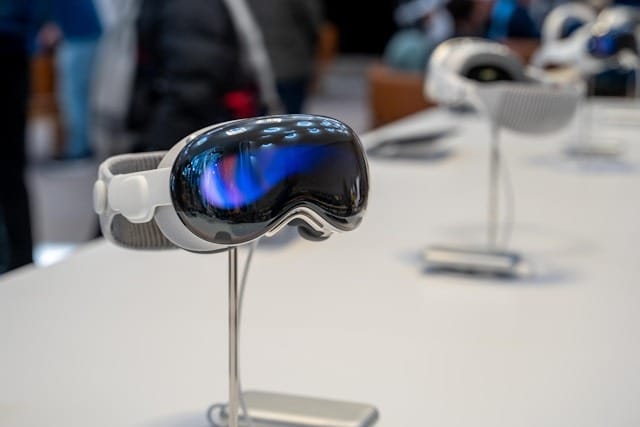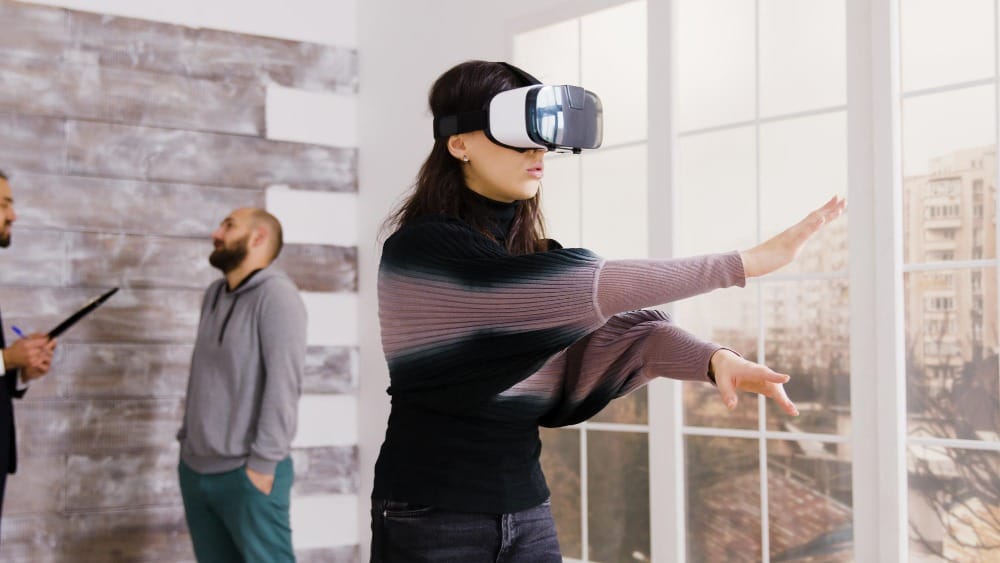Virtual Reality in Architecture: A Step Forward in Building Design
Virtual Reality in architecture is reshaping how you design, visualize, and experience built environments. By blending digital immersion with architectural precision, VR lets you step into a building long before it's built. You can explore layouts, adjust lighting, and sense spatial proportions in a simulated 3D world even before physically constructing or remodeling the space.
In this article, we will explore how Virtual Reality in architecture transforms modern design workflows, how VR is applied in architectural practice, and its benefits and challenges.
Understanding Virtual Reality in Architecture
Virtual Reality (VR) in architecture involves using immersive digital simulations to visualize and interact with design models. Instead of viewing static blueprints or 3D renders, you can walk through realistic virtual spaces using VR headsets and controllers.
Architectural VR technology allows you to experience designs at a human scale, offering deeper insight into spatial dynamics, materials, and lighting effects. This interactive perspective enhances collaboration between architects, engineers, and clients by bridging the gap between imagination and reality.
Key Applications of VR in Architectural Practice
The use of Virtual Reality in architectural applications extends across the entire project lifecycle. From conceptual design to client presentations, VR adds clarity and confidence to every stage.
1. Immersive Design Visualization
With VR design visualization, you can step inside your project and experience it on a human scale. You can walk through corridors, observe lighting at different times of day, and sense proportions with remarkable accuracy. This immersive understanding helps you identify design flaws early, experiment with materials, and present concepts that clients can see and feel, not just imagine.
2. Enhanced Client Presentations and Communication
Explaining complex architectural concepts to clients has always been challenging. VR eliminates this barrier by placing clients directly inside a virtual model, allowing them to experience the space as if it already existed. This direct engagement improves clarity, builds trust, and shortens approval timelines.
3. Virtual Reality in Urban Planning and Public Engagement
Using Virtual Reality in urban planning, you can simulate large-scale developments and assess environmental, traffic, and community impacts. Stakeholders can virtually walk through projects, improving transparency and collaboration. This technology ensures data-driven, inclusive urban design decisions.
4. Construction Coordination and Safety Training
During construction, VR helps you plan logistics, test sequences, and identify potential site hazards before work begins. Using Virtual Reality in architecture, you can rehearse installation sequences, validate safety protocols, and coordinate between multiple contractors in a shared 3D environment. These simulations reduce on-site risks and enhance team coordination.
5. Real Estate Marketing and Pre-Sales
Developers increasingly use architectural VR technology to market properties before construction. Prospective buyers can explore apartments, offices, or entire communities through immersive virtual tours. This realistic preview boosts engagement and drives early investment, as clients can experience the design long before the first foundation is laid.
6. Education and Skill Development
Educational programs integrate immersive architecture tools to enhance learning and spatial understanding. Students can explore realistic environments, analyze structures, and test design ideas instantly. This experiential approach builds practical design and visualization skills.
Technological Tools and Platforms in VR Architecture
Modern architectural practices depend on a range of software and hardware to bring VR experiences to life. These tools support real-time design visualization, collaboration, and simulation.

1. Hardware Devices
Headsets such as Meta Quest 3, HTC Vive, and Varjo XR-4 deliver lifelike graphics with spatial tracking. These devices enable architects to navigate digital models freely, making the experience intuitive and realistic.
2. Software Solutions
Key platforms for VR design visualization include:
Autodesk Revit Live integrates VR directly into BIM workflows.
Unreal Engine and Twinmotion provide photorealistic rendering for immersive presentations.
Unity Reflect enables real-time collaboration between architects and clients.
Enscape converts Revit or SketchUp models into instantly navigable VR scenes.
Each platform enhances Virtual Reality architecture applications, allowing you to experiment with designs in real time.
3. Integration with Other Technologies
VR connects seamlessly with Building Information Modeling (BIM), AI-driven analytics, and Augmented Reality (AR) tools. This integration supports efficient design iterations, energy analysis, and performance optimization. For instance, integrating BIM and VR helps architects detect design clashes early, reducing costly errors during construction.
Benefits of VR in Architecture
Implementing Virtual Reality in architecture offers numerous advantages for your design process and client relations.
Enhanced Design Accuracy: By experiencing your projects at full scale, you can detect design issues early. This prevents revisions later, saving time and resources.
Improved Client Engagement: Clients find it easier to make decisions when they can see and feel the proposed space. This engagement builds confidence and streamlines the approval process.
Better Collaboration: VR connects multidisciplinary teams in a shared immersive environment. You can host design reviews, annotate in 3D, and collaborate remotely — improving efficiency and communication.
Cost and Time Efficiency: Virtual walkthroughs reduce the need for physical mock-ups or rework. According to McKinsey & Company, digital tools like VR can shorten construction timelines by up to 20%.
Environmental Sustainability: Using Virtual Reality in architecture limits the need for printed materials and physical prototypes, reducing waste and supporting sustainable design practices.
Challenges and Limitations of VR in Architecture
While Virtual Reality in architecture offers immense potential, its implementation also comes with challenges. Understanding these limitations enables more informed decisions when adopting VR tools into your workflow.
1. High Initial Costs
VR systems require significant investment in both hardware and software. High-end headsets, motion sensors, and compatible computers can be expensive. Small firms may find the entry cost of architectural VR technology a barrier. However, costs are gradually declining as more accessible immersive architecture tools and cloud-based platforms emerge.
2. Technical Learning Curve
Integrating VR design visualization into daily operations demands technical expertise. Architects and designers may need training to use platforms like Unreal Engine or Revit Live effectively. This challenge can be mitigated through structured onboarding or by partnering with VR consultants specializing in architecture.
3. Hardware Limitations and Accessibility
Not every client or team member has access to VR headsets or high-end systems. This can limit participation in immersive reviews. Web-based viewers and mobile-compatible solutions are emerging to improve accessibility.
4. Data and Performance Issues
Rendering large architectural models in VR can strain system performance. Ensuring smooth navigation requires optimizing 3D assets and managing models efficiently. Cloud rendering technologies are gradually improving this, allowing you to stream complex environments without heavy local processing.
5. Human Factors
Extended VR sessions can cause motion sickness, disorientation, or eye strain for some users. Ensuring ergonomic design and stable frame rates minimizes discomfort. Balanced session lengths and user-friendly navigation improve comfort during VR design visualization experiences.
Future Trends and Innovations in VR for Architecture
The future of architecture technology lies in merging VR with complementary innovations such as artificial intelligence, Mixed Reality, and digital twins. These advancements will shape how you design, analyze, and interact with the built environment.
1. Integration with AI and Generative Design
AI-driven design engines will soon let you create and explore optimized structures directly in VR. Generative design tools can instantly simulate thousands of configurations, letting you experience the most efficient options in 3D.
2. VR and Digital Twins
Digital twins link physical buildings with their virtual counterparts. You can monitor performance, simulate maintenance, and visualize energy data in real time. This integration strengthens project management and sustainability efforts within Virtual Reality architecture applications.
3. Cloud-Based Collaboration
Cloud-enabled VR platforms will allow multiple users to inhabit and modify a design simultaneously, regardless of their location. This supports seamless teamwork across global design teams, reduces delays, and promotes real-time communication at every project stage.
4. Enhanced Haptic Feedback
Emerging haptic devices enable tactile sensations, allowing you to feel textures or materials in VR. This innovation deepens the sensory experience of architectural visualization.
5. Sustainable and Smart Cities
As cities move toward sustainable design, Virtual Reality in urban planning will play a central role. Governments and planners can test green infrastructure, pedestrian flow, and energy efficiency through immersive simulations.
Real-Time Examples: Implementation of VR in Architecture
Several architectural firms and developers have already embraced Virtual Reality applications in architecture, achieving outstanding results.

1. Project Correl by Zaha Hadid Architects
Zaha Hadid Virtual Reality Group (ZHVR) created Project Correl, an immersive, multi-user Virtual Reality experience where up to four participants collaboratively build evolving structures in a shared digital space. This project integrates real-time modeling, spatial scaling, and component placement under rule sets powered by Unreal Engine.
2. Foster + Partners' VARID Toolkit for Inclusive Design
Foster + Partners, in collaboration with City, University of London, and UCL's PEARL Lab, developed VARID, a design toolkit combining VR and AR to simulate vision impairments in architectural spaces. VARID helps you design more inclusive environments by showing how people with vision challenges perceive built spaces. The toolkit integrates easily with existing architectural VR technology.
3. Virtual Tours of Foster + Partners' Projects
Foster+Partners uses VR design visualization for virtual building tours, including their Bloomberg Headquarters. These walkthroughs allow clients to experience scale, light, and spatial flow before construction begins. This approach enhances presentations and improves client understanding of design intent
4. Structural Health Monitoring in VR for a Footbridge
Researchers used Virtual Reality to visualize real-time bridge data from LiDAR scans and simulations. Teams can explore the structure virtually, detect stress points, and plan maintenance remotely. This method increases safety and efficiency in infrastructure management.
5. UrbanVR for Context-Aware Urban Design
UrbanVR combines 3D visualization with urban design analytics, allowing you to explore large-scale projects interactively. Users can assess density, energy efficiency, and environmental performance directly within VR. This tool supports data-driven urban design and sustainable city planning.
6. Educational Institutions
Leading universities, including MIT and Stanford, incorporate immersive architecture tools into design studios. Students use VR to prototype projects and receive real-time feedback from professors and peers.
Conclusion
As technology reshapes the way you design and experience spaces, Virtual Reality in architecture stands out as a true game-changer. It transforms your creative vision into immersive realities, enabling your clients to see, feel, and interact with designs long before construction begins. From concept development to urban planning, VR enhances precision, collaboration, and storytelling in ways that traditional methods never could.
Bring your designs to life and advertise smarter with immersive storytelling. Unlock your creative potential with Flam and craft experiences that immerse your audience.